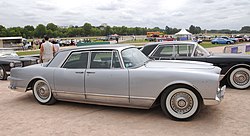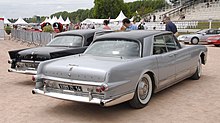Facel Vega Excellence
| Facel Vega Excellence | |
|---|---|
| Production period: | 1958-1964 |
| Class : | Upper class |
| Body versions : | limousine |
The Facel Vega Excellence was a luxury upper class sedan from the French car manufacturer Facel SA The model was produced from 1958 to 1964. It was first presented in Paris at the Mondial de l'Automobile in October 1956 in order to gain reviews from the specialist press.
history
Production began in 1958 and continued until the company closed in 1964. The car was built on the extended chassis of the Facel Vega FV and remained Facel's only four-door model. A total of 156 vehicles were produced. The low number of Excellence produced was due to the exorbitant purchase price of the car. For new vehicles, this was around four times the new price of a Citroën DS sedan . This already high price rose even further if you ordered special equipment that was gradually available over the course of the car's production period. These were, for example, power steering, brake boosters, power windows, wire-spoke wheels or air conditioning.
construction
The Excellence had design elements of contemporary, American cars, such as tail fins , panoramic windshield and missing B-pillars (" hardtop "). The basic shape with its headlights arranged above the indicators and the sleek, low appearance was clearly European. The low belt line and, in comparison, the high roof were typical construction elements of the late 1950s, which remained modern in the 1960s. The Facel Vega Excellence offered four doors. The rear-hinged rear doors together with the missing B-pillars gave rear passengers easy access. This layout was also found in Lancia and in the Cadillac Eldorado Brougham , which was only produced in a few copies, and which was presented at the end of 1956, as well as in the Lincoln Continental built between 1961 and 1969.
The interior was spacious, with leather-covered seats, an imitation walnut dashboard with rich instrumentation, and a make-up kit in the back of the center armrest. The latter consisted of a comb and a brush with chrome-plated handles and two - albeit empty - perfume bottles. Still, the interior was nowhere near as spacious as one would expect from a car with a wheelbase of more than three meters.
The Excellence was a high-performance vehicle and was one of the best GTs in Europe. Some American high-performance cars, especially the Chrysler 300 , were able to outperform the Excellence in engine performance, but were not so well designed and manufactured in terms of quality, nor did they offer the flair of a Facel Vega. Although the Excellence was not inferior to the large US limousines in terms of wheelbase, it was much shorter, narrower and, above all, lower than them. Its dimensions were comparatively compact and the road holding was better than comparable American vehicles.
In an article in the November 1985 issue of Collectible Automobile magazine , well-known automotive historian Richard Langworth wrote that, in his opinion, "(...) the Excellence is a great vehicle (...) that is better as a state car than for everyday use." How he came to this conclusion, contrary to the unanimously positive evaluations of the driving characteristics of the Excellence by the contemporary specialist press and also by its owners, has been a point of contention ever since.
Relationship with Chrysler
Like other Facel Vega models, the first Excellence were powered by the Chrysler V8 engines available at the time , the well-known Hemi engines that Chrysler produced until 1957. Facel used these engines until the end of 1958, when the last stocks were exhausted. Since then, the V8 Facel Vegas have been equipped with the Chrysler RB wedge big block engines.
All Facel Vega with Chrysler engines got either the four-speed manual transmission from Pont-à-Mousson or the three-speed automatic transmission TorqueFlite supplied by Chrysler . The American automatic transmission was available as an option at Facel Vega and in return the French four-speed manual transmission was offered as an option in certain Chrysler high-performance models.
Models
EX
| EX | |
|---|---|
|
Facel Vega Excellence EX |
|
| Production period: | 05 / 1958-10 / 1958 |
| Engines: |
Gasoline engine : 4.8–6.4 liters (184–270 kW) |
| Length: | 5235 mm |
| Width: | 1830 mm |
| Height: | 1380 mm |
| Wheelbase : | 3170 mm |
| Empty weight : | 1920 kg |
The Excellence EX exhibited at the Mondial de l'Automobile 1956 had a V8 engine with a displacement of 5424 cc. The first production series received a 4.8-liter engine with 250 hp (184 kW) and reached a top speed of 190 km / h, the second a 4.9-liter engine with 260 hp (191 kW) and was with three-speed TorqueFlite automatic transmission available from Chrysler or with a four-speed manual transmission. Standard equipment included leather seats, all-round tinted windows and power windows. A car phone was available as an optional extra , which was installed with the help of the French postal and telephone company PTT. From May 1958, the model received a version of the Hemi engine with 6423 cm³ displacement and an output of 367 hp (270 kW), which u. a. was also used in the HK 500 and the Imperial made by Chrysler . Contemporary driving tests showed that both the automatic and manual transmission versions brought the same performance to the road. The cars had drum brakes on all four wheels, with a diameter of 286 mm at the front and 280 mm at the rear. The fuel tank held 140 liters. Probably the most powerful Excellence ever built was a real 140-mile (224 km / h) car. Supposedly, seven of the eleven EX units built have survived to this day.
EX1
| EX1 | |
|---|---|
|
Facel Vega Excellence EX1 |
|
| Production period: | 10 / 1958-07 / 1961 |
| Engines: |
Otto engine : 5.9 liters (270 kW) |
| Length: | 5235 mm |
| Width: | 1830 mm |
| Height: | 1380 mm |
| Wheelbase : | 3170 mm |
| Empty weight : | 1920 kg |
At the end of 1957, Chrysler had stopped building the Hemi engines, and after stocks were exhausted, the Facel Vega were equipped with the Chrysler Wedge V8 engine with 5916 cc. Why the decision was not made in favor of the top-of-the-range Chrysler engine with a displacement of 6768 cc remains a mystery. The French, displacement-based vehicle control system is often cited as the reason.
Anyway, the 5.9-liter Excellence was anything but weak. It had the same power rating as its predecessor, which was equipped with the Hemi engine. From the end of 1959, front disc brakes were optionally available for the Excellence.
The Excellence EX1 , built between 1958 and 1961, was the most frequently built version with 137 units.
EX2
| EX2 | |
|---|---|
|
Facel Vega Excellence EX2 |
|
| Production period: | 07 / 1961-06 / 1964 |
| Engines: |
Otto engine : 6.3 liters (290 kW) |
| Length: | 5280 mm |
| Width: | 1830 mm |
| Height: | 1380 mm |
| Wheelbase : | 3180 mm |
| Empty weight : | 1920 kg |
The Excellence received its only facelift in July 1961. The wheelbase had grown by 10 mm and the external length by 45 mm. The engine was also bigger. It now had a displacement of 6276 cc and developed 394 hp (290 kW). This performance made people sit up and take notice, especially with a sedan. In contemporary driving tests, however, no noticeable improvement in driving performance could be determined. The first series of the Excellence with Hemi engine was and remained the fastest version ever built.
The EX2 no longer had a panoramic windshield and the tail fins were also severely trimmed, which gave it a much less extravagant appearance. Nevertheless, the appearance of the new model was by no means much more modern, but rather lost something of its earlier elegance. A completely new design would have been far too expensive, especially with the small number of copies. The EX2 reached a top speed of 200 to 210 km / h. It was equipped with the same disc brakes as the HK1 . Only eight copies of the EX2 version were made in three years, then the model series without a successor was discontinued.
In France, the base price for the EX2 with automatic transmission, shown for the first time at the Mondial de'l Automobile in October 1961, was NF 72,500, a price for which you could buy twelve Renault Dauphines .
Conversations with Studebaker-Packard?
At the suggestion of a conglomerate of investors based in New York City who were interested in buying the US luxury brand Packard in 1959 , negotiations are said to have taken place between the CEO of Studebaker-Packard Corporation , Harold Churchill , and Facel boss Jean Daninos. They wanted to offer the Excellence with Packard emblems and the typical Packard “Ochsenjoch” radiator grille through the more exclusive Studebaker-Packard dealers in the USA. This was vehemently denied by Daninos and presented as the "fantasy of an American car dealer". Facel's design office never dealt with such plans and he himself never had any contact with the Packard Motor Car Company or its successors.
The last Packard was built in 1958. The capacities gained through the cessation of production were then used for the new Lark compact car . Daimler-Benz , which had already entered into a sales partnership with Studebaker-Packard and used the Studebaker dealer network to sell their Mercedes-Benz brand in the USA, opposed this plan. Churchill had to realize that he could never get the same financial support from Facel as from Daimler-Benz, and so this project ended. The Facel Vega Excellence in Packard version reached the planning stage, but contrary to widespread rumors, a single prototype was never created.
Nevertheless, quite a few Excellence were exported to the USA by private individuals.
In the movie
A Facel Vega Excellence appeared in the 1959 film French Beds with Deborah Kerr and Maurice Chevalier .
Further excellence appears briefly in the film Do you love Brahms? from 1961, in the comedy series Le temps des copains and in the film 40 Million Seeking a Man from 1963, as well as in the films Slaughter from 1972 and The Ice Cold Wolf from 1990.
In each of these cases it was the EX2 version .
Remarks
- ↑ As mentioned, Daninos for Facel deny such plans. So it is unclear with whom Churchill negotiated.
Individual evidence
- ^ Jean Daninos: Facel-Véga . Édition EPA, Paris, Collection 'Grand Tourisme' No. 2. ISBN 2-85120-143-3 . P. 125
- ^ Jean Daninos: Facel-Véga . Édition EPA, Paris, Collection 'Grand Tourisme' No. 2. ISBN 2-85120-143-3 . P. 51
- ^ A b Jean Daninos: Facel-Véga . Édition EPA, Paris, Collection 'Grand Tourisme' No. 2. ISBN 2-85120-143-3 . P. 55
- ↑ a b c d Jean Daninos: Facel-Véga . Édition EPA, Paris, Collection 'Grand Tourisme' No. 2. ISBN 2-85120-143-3 . P. 122
- ^ Jean Daninos: Facel-Véga . Édition EPA, Paris, Collection 'Grand Tourisme' No. 2. ISBN 2-85120-143-3 . P. 120
- ^ Jean Daninos: Facel-Véga . Édition EPA, Paris, Collection 'Grand Tourisme' No. 2. ISBN 2-85120-143-3 . P. 126
- ^ A b Jean Daninos: Facel-Véga . Édition EPA, Paris, Collection 'Grand Tourisme' No. 2. ISBN 2-85120-143-3 . P. 121
- ↑ a b c d Automobilia - Toutes les voitures francaises 1962 (salon Paris oct 1961) in Histoires et Collections , Paris, No. 19: p. 48. 1200
- ^ Jean Daninos: Facel Vega. 1981, p. 109.
literature
- Jean Daninos: Facel-Véga ; Edition EPA Paris, Collection 'Grand Tourisme' No. 2, ISBN 2-85120-143-3 (French)



